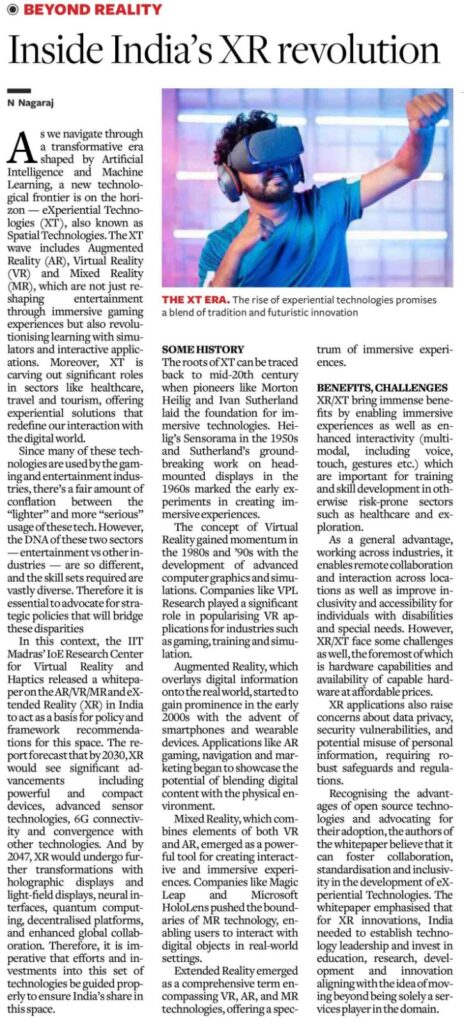PDF (high res) version – 16MB
PDF (low-res) version – 2MB
Release Date: 14th Mar 2024, at IIT Madras, Chennai
Released by XTIC, IIT Madras.
Authors of the Whitepaper:
- Dr.M. Manivannan, Professor, in-charge of Experiential Technology Innovation Center, IIT – Madras
- Raghavendra Achari, Experiential Technology Innovation Center, IIT –Madras
- Dr.A.Damodaran, Distinguished Professor, ICRIER, New Delhi.
- Jayashree Parthasarathy, National Informatics Centre, Chennai
- Ashok Maharaj, Head of XR Labs, Tata Consultancy Services
- Chitra Chandrashekhar, Creative Founder-Visual Story Designpreneur
- Rabindra Sah, Chief Engineer, Tata Technologies
- Avi Dwivedi, Founder, XRDI
- Sreenath, Founder, Busifrog Tech Pvt. Ltd.
- Ganesh S, Vice President, ICT Academy
- Keyur Bhalavat, CEO, Plutomen Technologies Pvt. Ltd.
- Suhas P. Bhagwat ([email protected]), Founder, Avroglide Consultants
- Suneel Sharma, SKYZ Hotech Solutions Pvt. Ltd.
- Dr.A. Paventhan, Director, ERNET
- Dr. Jayanth Murali, DGP (Retired)
- Rohit Singh, Product Manager, Trezi
- Pravin Hungund, Indian Administrative Fellow, The Nudge Institute, RDPR, GoK
- Kuldeep Singh, Technology Director, Thoughtworks
- Milind Manoj, Founder, PupilMesh
The Whitepaper provides a comprehensive overview of eXperiential Technologies (XT) and their potential impact on various sectors in India. Here are several commendable aspects of the write-up:
Comprehensive Definition and Scope:
- Clarity in Terminology: The write-up effectively defines and explains various terms associated with experiential technologies, providing readers with a clear understanding of the scope, including Virtual Reality (VR), Augmented Reality (AR), Mixed Reality (MR), Extended Reality (XR), Metaverse, Web 3.0, and Haptics.
- Ambitious Integration: The acknowledgment of experiential technologies as a part of the ambitious Digital India initiative is well-argued. The integration of these technologies with other emerging fields like AI, Blockchain, Robotics, IoT, and 5G is rightly emphasized, showcasing a holistic approach towards technological development.
Gap Analysis and Skills Development:
- Strategic Assessment: The incorporation of a gap analysis to assess XR skills in India, in line with global initiatives, is a commendable strategic move. Identifying gaps in hardware, software, and application skills helps outline a roadmap for skill development.
- Proposed Initiatives: The proposal for an XR-Superhighway, XR-Corridor, XR Innovation Centers, XR Skill Training Centers, XR Experience Spaces, XR Manufacturing Centers, and XR Education Centers indicates a well-thought-out strategy for infrastructure and skill development.
Metaverse Development and Governance:
- Critical Considerations: The focus on developing and governing the metaverse while considering privacy, security, monetization, fairness, and other crucial factors demonstrates a forward-looking and responsible approach. The creation of the Metaverse India Policy and Standards (MIPS) forum adds a structured governance layer.
- Technology Mission Objectives: The outlined objectives of the MIPS forum, emphasizing the foundational elements, human embodiment in virtual space, R&D, and leveraging India’s IT and cyberspace sector, showcase a multifaceted strategy.
Open Source and Innovation:
- Advocacy for Open Source: Recognizing the advantages of open-source technologies and advocating for their adoption is a forward-thinking approach. This can foster collaboration, standardization, and inclusivity in the development of experiential technologies.
- Emphasis on Innovation: The acknowledgment that India needs to establish technology leadership and invest in education, research, development, and innovation aligns with the idea of moving beyond being solely a services player in the technology domain.
Macro-Economic Vision:
- Strategic Economic Vision: The articulation of India’s need to establish leadership in experiential technologies to gain a macro-economic stronghold is ambitious and underscores the strategic vision for the country’s technological future.
- Emphasis on Hardware Development: Recognizing the importance of investing in hardware and manufacturing infrastructure distinguishes the vision by addressing both digital growth and industrial development.
XR Revolution and Evolution
- By 2030, Extended Reality (XR) will see significant advancements including powerful and compact devices, AI-driven content, advanced sensor technologies, 5G connectivity, and convergence with other technologies.
- By 2047, XR will undergo further transformations with holographic displays, neural interfaces, quantum computing, decentralized platforms, and enhanced global collaboration. These advancements will prioritize human connection and reshape interactions with the world, leading towards a future where XR fosters a sense of global community and enables profound levels of immersion and telepresence.
Government Policy and Investment:
- Role of Government: The write-up correctly highlights the crucial role of the government in creating a favorable climate for investments in XR. The call for policies that encompass technology development, research, innovation, deployment, integration, and scaling is a holistic approach.
- Emphasis on IP Development: The emphasis on India taking ownership of technology and intellectual property (IP) aligns with the need for economic gains beyond services, showcasing a mature understanding of the economic dynamics in the technology sector.
The whitepaper presents a vision for India to become a global leader in experiential technologies, emphasizing strategic planning, skills development, metaverse governance, open-source adoption, innovation, and government-led initiatives. The outlined objectives and proposed initiatives indicate a forward-thinking and comprehensive approach to positioning India at the forefront of emerging technologies.
The Hindu Business line has written an exclusive article on this Whitepaper, dated 28th April 2024

